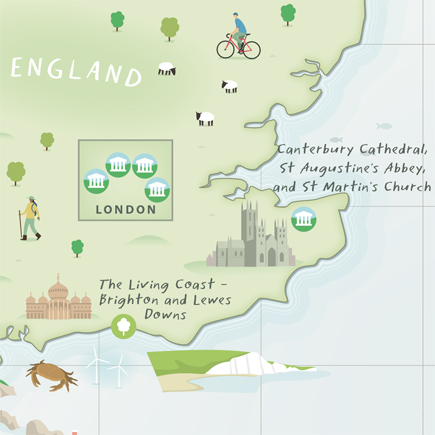Imagine a stretch of land and sea with a spirited city at its heart. Bordered by two rivers, its green chalk hills (the ‘Downs’) roll down to river estuaries, white cliffs, shingle beaches and chalky offshore reefs, sheltering rare and remarkable natural habitats.
This is The Living Coast, the Brighton & Lewes Downs UNESCO Biosphere Region.
A map featuring all 58 United Nations Education, Scientific and Cultural Organization (UNESCO) sites in the UK is available to download.

The map, illustrated by artist Tom Woolley, was launched by UNESCO to raise awareness of the breadth of natural, cultural and built heritage sites throughout the country.
The map features The Living Coast, our local UNESCO Biosphere that Brighton & Hove and Lewes sit at the heart of, stretching from the South Downs to the coast, and from Shoreham-by-Sea to Newhaven.
Here people and nature have co-existed for thousands of years, the relationship inspiring art and crafts, tastes, traditions and distinctive ways of life. Here, you can marvel at swirling murmurations of starlings over Brighton’s skeletal West Pier at sunset, or search for dainty orchids on the Downs. Savour award-winning local wines or fresh-picked produce in farmers markets. Shop for hand-crafted treasures in chic boutiques or quirky art galleries. And cycle or take the bus to explore wooded trails, flowing seaside paths or breath-stealing hills.
What is Brighton & Lewes Downs UNESCO Biosphere Region?
The Living Coast is a UNESCO World Biosphere Region, a region rich in cultural and natural heritage. Biospheres exist to inspire positive futures for people and nature. Of the 701 biospheres worldwide, The Living Coast is one of a handful that includes a large urban area. This gives it an outstanding opportunity to support projects that pioneer ways to balance the daily needs of people and nature.
It stretches between the rivers Adur and Ouse, where the chalk grasslands of the South Downs National Park meet the English Channel, the chalk extending beneath the shingle and the waves and into a Marine Conservation Zone.
The diverse natural habitats within The Living Coast – including dry chalk valleys, floodplain meadows, vegetated shingle and chalk reefs – are home to rare plants and wildlife, like the Adonis blue butterfly and the shy short-snouted seahorse. From the river estuaries of Shoreham-by-Sea and Newhaven, to the historic seaside city of Brighton & Hove and the market town of Lewes, the region has a long heritage of humans benefiting from a close relationship with nature.
Today, The Living Coast aims to be a thriving environment for all. A place where people can connect with nature and live well together, enjoying, celebrating and reinvigorating the natural wonders of this shared space.


 to add an item to your Itinerary basket.
to add an item to your Itinerary basket.








.png)


